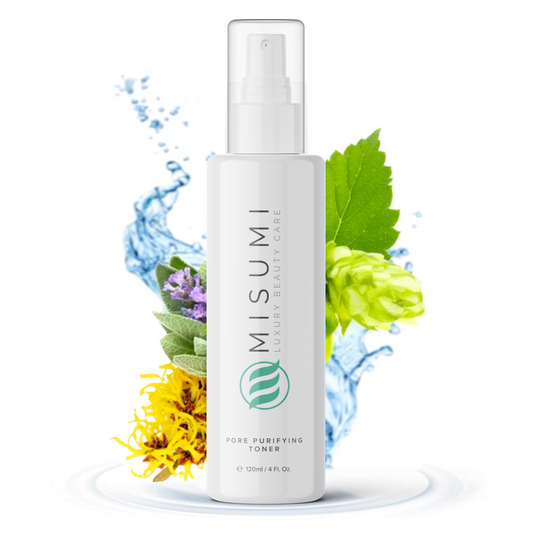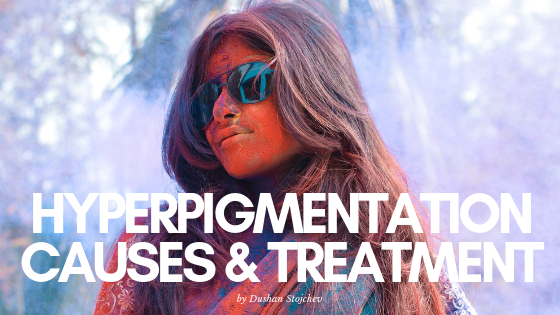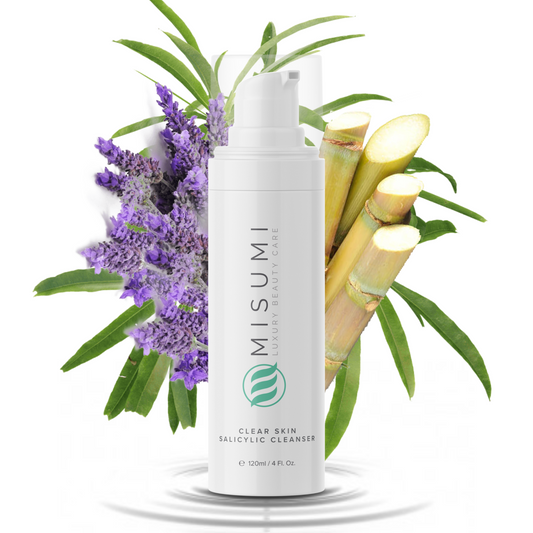With summer fast approaching, you’re probably looking forward to getting a nice tan. Or, perhaps just maintaining your normal, usual skin tone. Whatever the case might be, ideally, you want to have control over your skin’s tone and coloration. That is why today we’ll be tackling the problem of hyperpigmentation, its causes and treatments.
What Is Hyperpigmentation?
Well, if we break down the word, we get “hyper” and “pigmentation.” Chances are you can already guess what the word stands for - the “pigment” part meaning the tiny, invisible particles that provide your skin with color. And “hyper,” coming from ancient Latin, meaning “over,” “greater,” or “too much.”

In short, hyperpigmentation means the excessive, or unexpected, darkening of the skin. It’s a specific type of discoloration of the skin, where the skin is darker than usual. What leads to this is the excessive overproduction of pigment in your skin cells, a process that can be due to several different reasons.
It may seem like a fairly ordinary, and even a natural phenomenon, but things get complicated once you want to change or reverse it. Hyperpigmentation is one of the most stubborn conditions to get rid of in dermatology and general skincare. What complicates treatment is the fact that hyperpigmentation happens when multiple mechanisms converge and cause our skin’s pigment production to go into overdrive. Until you, or your dermatologist, figures out exactly which factors are in play, it’s very difficult to do anything about hyperpigmentation.
Hyperpigmentation isn’t a localized phenomenon. It can affect a very tiny spot on your skin, or it can cover larger areas, entire body parts, or even your whole body. While hyperpigmentation generally isn’t harmful, it can sometimes indicate changes that are symptomatic of an underlying medical condition.

Types And Causes Of Hyperpigmentation
However, you shouldn’t worry. The problem with hyperpigmentation is largely aesthetic, and there are several types of it. In this primer of ours, we’ll go over the four most common types of hyperpigmentation, determined mainly by what caused them. It’s a pretty elegant system, because the type of hyperpigmentation also tells us what causes it.
Melasma Hyperpigmentation
This kind of hyperpigmentation, called melasma, is very common. Most people end up having it on their faces, especially on the bridge of the nose, their forehead, on their cheeks and so on.
Melasma manifests itself as dark, gray-brown, or brown patches over the affected area of the skin. Typically, these patches are… Well, patches. They resemble freckles, but they’re less round and not regularly shaped. They’re closely packed together, but usually separated by thin areas of healthy skin of normal color.
Changes in the hormonal balance are thought to be the most common cause for melasma, at least for women. These hormonal changes can be caused by taking birth control pills, certain kinds of contraceptives, pregnancy, or any other kind of therapy that includes hormones. However, it’s not always hormones that are driving the melasma type of hyperpigmentation. Often times, the hormones are just a piece of the puzzle, and the rest of the mosaic is comprised of prolonged exposure to the sun.

Photoaging Hyperpigmentation
As we mentioned in the introduction, hyperpigmentation is usually caused by several factors in combination. For example, hyperpigmentation can often be triggered by prolonged exposure to the sun, a phenomenon also known as photoaging. The sun’s UV rays can throw the skin cells that regulate pigment (called melanocytes) out of whack. This causes an overproduction of melanin, leading to hyperpigmentation in certain places and a general unevenness of skin pigment.
This sun-caused hyperpigmentation leaves darkened formations over the surface of the skin. These formations are called sunspots, or sometimes people refer to them as solar lentigines or liver spots. While they’re completely natural, most people aren’t happy when their skin suddenly starts looking like a dalmatian. Usually, sunspots appear on areas of the body that are most exposed to the sun’s light, like the face and the arms.

Post-Inflammatory Hyperpigmentation
Post-inflammatory… Hmm. A bit ambiguous, isn’t it? Have you noticed how even some relatively minor injuries can leave not so much a scar, but a darkened spot on the skin after they’ve healed? What you’re looking at in that case is post-inflammatory hyperpigmentation. Almost any sort of injury of the skin, or skin condition can cause inflammation, and with it, hyperpigmentation.
However, the most common post-inflammatory hyperpigmentation comes as a consequence of acne. You’ve had a pimple, or a bunch of them, they’re pretty much gone now… But they’ve left these dark spots all over the place. What happens is that the skin becomes irritated by the injuries of the tissue that acne causes, which messes with the melanocytes. (Melanocytes, if you recall, were the skin cells in charge of regulating the amount of pigment in the skin.)
So, whenever an injury to the skin occurs, be it due to acne, a thin cut made by your cat’s claws, or an insect bite - the skin rolls a dice. It heals itself up, but while it does that, it decides whether to also pump up more pigment in the area and make your skin darker. The end result? Post-inflammatory hyperpigmentation.

Genetic Hyperpigmentation
We read the word genetic, and it suddenly sounds so ominous, right? But that’s not the case when it comes to genetic hyperpigmentation. Because what we’re talking about here is.. Freckles. And we can all agree that freckles are far from ominous, right?
While freckles usually increase the cuteness factor of whoever is blessed to carry them, they are, technically speaking, areas of hyperpigmentation. And since these tiny, round brown, dark, or pink spots are hereditary, that makes them genetically determined. As you probably know, freckles don’t appear everywhere uniformly. They’re pretty irregular, but some of their favorite places include the cheeks, the nose, and the hands of the befreckled person.
Dermatologists tell us that freckles are not always present for our entire lives. You’d rarely see a freckled baby, because freckles typically appear in childhood, and sometimes even later in life. However, freckles are also enhanced by exposure to the sun. (The sun’s rays are a common theme when we discuss hyperpigmentation, because its UV rays are one of the main contributors to it.)
So, what can be done? Not much, I’m afraid. People with freckles are predisposed to developing patches of hyperpigmentation over their skin, so at least, limiting sun exposure is one way to go about it. But what else can be done to treat, and prevent hyperpigmentation? Let’s see.

Hyperpigmentation Treatment And Prevention
So, we went through the various causes - and types of - hyperpigmentation. But what about treatment? As we mentioned briefly in the introduction, hyperpigmentation has quite the reputation of a stubborn skin condition. That’s because it rarely appears as the cause of just one factor.
In the vast majority of cases, a person’s hyperpigmentation is the result of both sun exposure, a hormonal imbalance or two, and some sort of irritation of their skin. And even if we treat two of those factors, the third one can remain relatively untouched. For example, hormonal balance can be restored, and the sun can be easily avoided. However, there is very little that we can do to interfere in the microscopic processes that govern the production of pigment during the closing up of the wounds.
However, science is hard at work at tackling all of these processes, and while there is no magical cure, or no magical pill that would prevent hyperpigmentation, there are many things we can do to restore the normal tone of the skin.

Hyperpigmentation Prevention
But before we move on to specific treatments, let us see what we can do to prevent hyperpigmentation.
Prevent Hyperpigmentation By Spending Less Time In The Sun
As we mentioned above, exposure to the sun is one of the main risk factors when it comes to hyperpigmentation. People who are genetically predetermined to experience it are especially vulnerable, since it won’t take long for their skin to show signs of melasma or sunspots. But even people with normal skin, and who are not predisposed to it can end up with sunspots or freckles. This is because exposure to the sun’s UV rays can trick our skin cells in charge of producing pigment, called melanocytes, to ramp up their activity.
So, what can you do? Well, there are ways to prevent all this. For one, try to avoid going out when the sun is too strong. If that’s not an option for you, however, then trying to dress lightly while covering your body as much as possible is a good idea. If necessary, you can wear broad-brimmed hats that will offer further protection from the sun’s UV rays. And finally, a high-quality sunscreen is your best friend. If you’re prone to hyperpigmentation and sunspots, or you just want to prevent them, always use a sunscreen with an SPF of at least 30 or more.

Avoid Certain Medications To Prevent Hyperpigmentation
Avoiding certain classes of medications may also prevent hyperpigmentation, especially if they are hormone-based. In order to discern which medication and which hormone may be contributing to your case of hyperpigmentation, scheduling a visit to your doctor and dermatologist is your best bet.
Additionally, certain chemotherapy drugs can have the side effect of causing undue hyperpigmentation as well. Again, your only resort in preventing such outcomes would be to inquire with a medical professional, since they would be thoroughly informed on the topic.

Pregnancy And Certain Diseases Can Also Cause Hyperpigmentation
While these are more difficult, and sometimes (in the case of pregnancy) often undesirable to prevent, they can still contribute to hyperpigmentation.
As we mentioned, hyperpigmentation often occurs as the consequence of a shift in the hormonal balance of a person. And in women, one of the most tectonic events when it comes to changing hormones is pregnancy. Pregnancy modifies hormone levels drastically, which can affect melanin production in some women.
Another factor that may change the hormonal makeup of a person is if they suffer from a disease that affects the glands. For example, endocrine diseases, like Addison’s disease, can disrupt hormone levels, causing an increase of melanin production in turn. Finally, excessive exposure to the sun can also cause a hormonal shift, leading to an eventual increase in melanin.

Hyperpigmentation Treatments
While there is a great number of potential causes for hyperpigmentation, the number of potential treatments is high as well. Note my intentional use of “potential” here, dear reader. In the introduction, we mentioned that hyperpigmentation was one of the most difficult skin conditions to get rid of. (Or, skin features to change, depending on how you want to look at it.) That’s because hyperpigmentation is a very natural process, if we’re being honest. Our bodies are simply designed to produce more melanin when we stay too long in the sun. It’s a way for our skin to protect itself. However, sometimes it can be an unintentional side effect, due to hormones or medications.
Whatever the cause may be, every person’s skin is different, and will respond differently to the hyperpigmentation medications and treatments. These treatments vary from bleaching creams and gels, all the way to lasers and other medical procedures. Hyperpigmentation is one of the most stubborn conditions to treat, but let’s see what we have at our disposal.

Lightening Creams Can Reduce Hyperpigmentation
Head over to the local cosmetics store, and chances are you’ll find at least a dozen or so skincare products that offer skin lightening effects. Most of these contain a substance called hydroquinone, a powerful bleaching agent. Retinoic acid is also helpful in lightening the dark patches of hyperpigmentation, so it’s often used in lightening creams as well.
While most of these are available for purchase over-the-counter, there are usually stronger versions that you can only get by a doctor’s prescription. It goes without saying that you should always follow the instructions that come with the product, and be patient. Treating hyperpigmentation takes time, and lightening creams work best for melasma and hyperpigmentation due to sun exposure.

Face Acids For Hyperpigmentation
AHAs and BHA are some of the most helpful natural acids when it comes to treating hyperpigmentation and lightening your skin. These acids, such as glycolic acid, ferulic acid, lactic acid, citric acid or salicylic acid work their magic by exfoliating the surface layers of the skin. They help remove the dead skin cells, which cover our skin like a thin, dark patina. By using these acids, they remove the surface layer of dead skin cells, making your skin look lighter.
Retinoids Can Help Treat Hyperpigmentation
Vitamin A is one of the essential vitamins when it comes to regulating the processes that maintain healthy skin. Retinols, also known as retinoids, are known as “analogues” of Vitamin A, which means a different configuration of the same vitamin. The deal with retinoids and retinoids is that they are the most effective form of Vitamin A when it comes to regenerating your skin. While you can find many retinol-based creams OTC, they are usually weaker. In order to reverse hyperpigmentation, you may need a stronger form (called tretinoin, Retin-A or even isotretinoin (brand names Accutane or Roaccutane and many others) which can be prescribed by your doctor or dermatologist.

Chemical Peels For Hyperpigmentation
Remember the acids from above? Well, they can be used as chemical peels which contain a more intense, concentrated formula. Imagine a normal exfoliation, and then imagine an even deeper “peeling” of your skin. Sometimes, chemical peels can even remove the surface layer of the skin and refresh the middle layer of the skin. This restarts the restorative mechanisms of your body, which begins pumping out collagen, and in doing so repairs your skin.
Even though you can find a DIY chemical peel product in your local cosmetics store, the best, and safest chemical peels are performed by experienced dermatologists. Don’t compromise when it comes to chemical peels, because it can cost you irritation, redness, an allergy, and even scars.

Laser Resurfacing Can Repair Hyperpigmentation
Also called laser peels, laser resurfacing treatments harness the power of high-intensity beams of light to target specific layers within the skin. Depending on the type of the laser and the lens mounted on the machine, laser resurfacing treatments can even target formations of pigment inside your skin. And… Explode them.
You read that right. That’s exactly what laser resurfacing does, but you should rest easy, because dermatologists take great care to make the entire process as painless and comfortable as possible. It can be said that laser resurfacing treatments is one of the most effective, but at the same time most expensive and least pleasant treatments for hyperpigmentation.
Intense Pulse Light Therapy (IPL) For Hyperpigmentation
A subset of laser resurfacing procedures, IPL treatments represent a type of non-ablative laser treatment. Non-ablative means that no tissue gets destroyed or removed. Instead, IPL, being non-ablative, works by delivering heat within the cells inside your skin, making them go into emergency mode. The heat blasts trick the skin cells into producing more collagen, and restarting the repair mechanisms of the skin. This gives your skin a chance to re-do the areas of the skin affected by too much pigment, replacing them with clear, healthy skin.

Microdermabrasion As Treatment For Hyperpigmentation
Microdermabrasion is a specific, medical exfoliating procedure that’s performed by certified dermatologists (in-office). The treatment entails sprinkling microscopic crystals over your epidermis (the top layer of the skin) and then vacuuming those crystals up. This manages to peel off the surface layer of your skin and clean up all the dead skin cells, restoring your appearance to a cleaner look.
While microdermabrasion is usually used for the removal of superficial scars, it can also be used to attempt to reduce, or revert, hyperpigmentation. But if it can remove shallow wrinkles and particular blemishes or sun spots, chances are it can work well for milder cases of hyperpigmentation as well. Keep in mind, however, that it will probably take multiple treatments until you’ll be able to see results.

Dermabrasion For Hyperpigmentation
Dermabrasion is just another name for a deeper, and more abrasive form of microdermabrasion. And just as with microdermabrasion, dermabrasion is primarily used for treating deeper types of wrinkles, or acne scars, scars due to injury and other injuries to the skin. It can be used, however, to tackle hyperpigmentation as well. The “abrasion” properties of dermabrasion reach deeper than its micro-variant, reaching all the way down to the dermis.
This means that dermabrasion can help you regenerate your skin on a deeper level than microdermabrasion, thereby making it a more effective treatment for hyperpigmentation. As always, you should discuss this with your doctor and dermatologist, and make sure that treating your case of hyperpigmentation with the help of dermabrasion is the right treatment for you.

Conclusion
Hyperpigmentation is one of the most common, but also one of the most persistent types of skin discoloration. It can be caused by numerous factors, with the most common ones being hormonal imbalance, prolonged exposure to the sun, inflammation or - as in the case with freckles - genetic predisposition. As you might have noticed, hyperpigmentation is in large degrees, natural. Which makes it very challenging to remove or reduce. However, science offers a number of treatments. Ranging from lightening creams to laser resurfacing treatments, modern dermatology offers many hyperpigmentation treatments that can restore your skin to its original, youthful state.
This information is meant to supplement, not replace advice from your doctor or healthcare provider and is not meant to cover all possible uses, precautions, interactions or adverse effects. This information may not fit your specific health circumstances, and its goal is to offer a general view of the subject. In case you are suffering from a severe case of acne, you should consult with a dermatologist or a certified medical professional.










